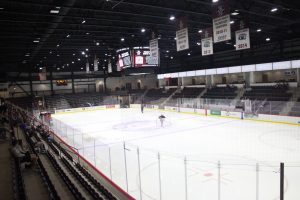The need for a paved pathway between Richmond and West parking lot
The path between Richmond and the parking lot. At the start of fall term, the dirt here was a narrow band, now multiple people can walk along it.
October 27, 2022
The lack of a paved pathway between Richmond and the West parking lot and the stairs to Seward Place is an oversight that ought to be resolved. Between the western part of Richmond and the West parking lot, a social trail has formed. Made entirely by necessity and the repeated movement of students and other passers-by, the trail is clearly distinguishable from the nearby grass. The path itself is a hazard, and seasonal weather makes it worse. For the sake of everyone living on Seward Place and beyond, please, pave us a path.
The path itself is simply a grassless strip that stretches from the west entrance of Richmond down the slope to the parking lot below. But the volume of foot traffic on the shows how vital it is to the everyday life of students who have to walk to campus every day.
Seasonal changes create extra difficulty in navigating the path. In fall, fallen leaves get wet and clog the trail, making the path slippery. Spring showers turn the path itself to mud. But winter is by far the worst. The snow does not hinder movement up the slight hill, but when it’s compacted into ice, it can. The snow does offer an interesting opportunity to see how people move along the path, although torn out grass and mud show the same cycle happens the whole year.
It begins with a person or two, their steps clearly defined in heavy snow. Sometimes, it’s clear passers-by know that a path will form, and they will drag their feet along, creating long lines in the snow. The path begins to widen, not as much during warmer months, but sometimes enough to have two people walk next to each other. Trouble begins as the snow becomes more and more compacted, creating ice. The pathway widens as students attempt to avoid the ice. The cycle repeats. I’ve personally slipped several times on the compacted snow. Sometimes, when rains freeze, the path is too steep, and alternate paths at a less steep grade will be formed spontaneously. Sometimes, it makes more sense to run down the slope, into traffic in the hope of not standing too long on the ice.
The same thing happens in other seasons too. The patch of dirt in the grass gets wider and wider. Stepping on the mud might be dangerous, so it becomes better to avoid it; to step right next to it. To widen the path.
This is not only a problem for those living on Seward Place. If Union hopes to move students to a hockey field by Mohawk Harbor, many students will take this path to get there. A path here may be belated, but it’s also future-proofing the campus.







